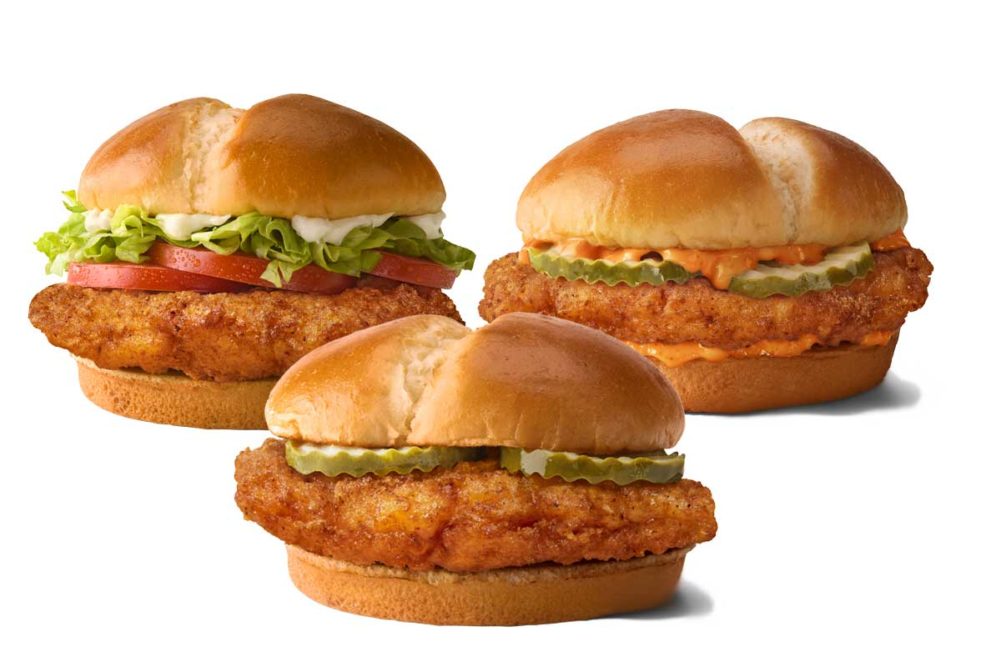CHICAGO — The launch of three new crispy chicken sandwiches in February marked the beginning of a “multiyear chicken journey” at McDonald’s Corp., said Joseph Erlinger, president of McDonald’s USA.
“While the category is very competitive, we are so far exceeding our projections,” Erlinger said during an April 29 earnings call. “We are selling substantially more chicken sandwiches compared to our previous chicken sandwich line and seeing strong unit movement, especially after 4:00 p.m.”
McDonald’s executives are bullish on chicken. The three sandwiches feature a new crispy all-white meat fillet served on a new toasted, buttered potato roll. The traditional crispy chicken sandwich has pickles. A spicy option is topped with a spicy pepper sauce and pickles, and a deluxe sandwich has shredded lettuce, Roma tomatoes and mayonnaise.
“I feel very confident about this chicken sandwich,” Erlinger said. “I know and I absolutely acknowledge … that we’ve had many ins and outs of chicken sandwiches over the years. But I think we did our research. We really grounded ourselves in the consumer on this one in a significant way.”
He said the spicy offering is appealing to a younger and more diverse set of consumers.
Christopher J. Kempczinski, president and chief executive officer of McDonald’s Corp., said chicken is a “holistic strategy” for the fast-food company.
“So, it's not just going to be predicated on one sandwich,” he said. “We've got a very strong nuggets platform. We have McChicken. And so, one of the things that Joe and the team did, I think, went really well in the US is leveraging the other aspects of our chicken portfolio. We had nuggets that ran in front of then the chicken sandwich launch. And using sort of everything in our arsenal there to drive chicken is going to be one of the things that I think is different this time.”
Another menu strategy that appears to be successful is breakfast. Industrywide the daypart has been challenged over the past year as the pandemic drastically reduced work commutes. McDonald’s breakfast sales have improved in recent quarters, in part due to quicker drive-thru times, as well as new items launched last fall, including an apple fritter, a blueberry muffin and a cinnamon roll, that marked the first addition of bakery offerings to the company’s core menu in more than eight years.
“We're acutely focused on this daypart because we believe that certainly, as some consumer habits return to pre-pandemic ways of life, that the breakfast daypart will continue to come back,” Erlinger said. “And similar to the way that it was a real market share battle pre-pandemic, we think that market share battle will absolutely continue, and we're ready and prepared for that.”
The management team credits a trifecta of initiatives — maximizing marketing, committing to the core menu, and doubling down on digital, delivery and drive-thru — for growth in the first quarter that exceeded pre-pandemic levels for the period.
“The values and brand-based decisions we've made, along with simplifying our menus, strengthening our digital business and recommitting to our core are having a multiplier effect,” Erlinger said.
Net income in the first quarter ended March 31 was $1.5 billion, equal to $2.01 per share on the common stock, up 39% from $1.1 billion, or $1.47 per share, in the prior-year period. Results reflected stronger performance in the United States due to higher sales-driven restaurant margins, as well as $135 million in pre-tax strategic gains, primarily related to the sale of McDonald’s Japan stock, which reduced the company’s ownership by an additional 3%.
Revenues increased 9% to $5.1 billion from $4.7 billion.
“Despite resurgences and continued operating restrictions in many parts of the world, I'm pleased to share that in the first quarter, global comp sales and revenues have already surpassed Q1 2019 levels,” Kempczinski said. “Not surprisingly, we expect McDonald's to deliver strong global comp sales and revenue growth against 2019 levels for the full year, reflecting the strength of our business and the pent-up customer demand we're seeing as markets reopen.”
Global comparable sales increased 7.5%, reflecting positive results across all segments, compared to the year-ago period that was significantly impacted by the pandemic. In the United States, comparable sales increased nearly 14%, benefiting from average check growth with double-digit positive comparable sales across all dayparts. Growth in delivery and digital platforms contributed to results.
In McDonald’s international operated markets, a modest bump in comparable sales reflected strong performances in the United Kingdom, Australia and Canada, partially offset by substantially negative comparable sales in France and Germany. Many markets continued to be affected by restrictions on restaurant operations. Comparable sales growth in international developmental licensed markets improved sequentially through the quarter and primarily were driven by China and Japan.
European markets are experiencing mixed results due to varying responses to the pandemic, Kempczinski said.
“Our dining rooms are closed in about 50% of our restaurants in Europe,” he said. “As you know, dining rooms or dine-in is a big part of our European business. And so getting those open, I think, will be another important step for us in getting momentum back into the European business.”


